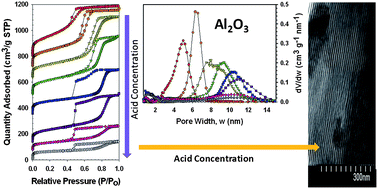Effect of acid concentration on pore size in polymer-templated mesoporous alumina†
Abstract
Ordered mesoporous

* Corresponding authors
a
Department of Chemistry and Biochemistry, Kent State University, Kent, USA
E-mail:
jaroniec@kent.edu
Fax: +01 330 672-3816
Tel: +01 330 672-2891
Ordered mesoporous

 Please wait while we load your content...
Something went wrong. Try again?
Please wait while we load your content...
Something went wrong. Try again?
S. M. Grant and M. Jaroniec, J. Mater. Chem., 2012, 22, 86 DOI: 10.1039/C1JM13592A
To request permission to reproduce material from this article, please go to the Copyright Clearance Center request page.
If you are an author contributing to an RSC publication, you do not need to request permission provided correct acknowledgement is given.
If you are the author of this article, you do not need to request permission to reproduce figures and diagrams provided correct acknowledgement is given. If you want to reproduce the whole article in a third-party publication (excluding your thesis/dissertation for which permission is not required) please go to the Copyright Clearance Center request page.
Read more about how to correctly acknowledge RSC content.
 Fetching data from CrossRef.
Fetching data from CrossRef.
This may take some time to load.
Loading related content
